Báo cáo y học: "Effect of corticosteroids on phlebitis induced by intravenous infusion of antineoplastic agents in rabbits"
Bạn đang xem bản rút gọn của tài liệu. Xem và tải ngay bản đầy đủ của tài liệu tại đây (1.52 MB, 6 trang )
Int. J. Med. Sci. 2009, 6
http: //www.medsci.org
218
I
I
n
n
t
t
e
e
r
r
n
n
a
a
t
t
i
i
o
o
n
n
a
a
l
l
J
J
o
o
u
u
r
r
n
n
a
a
l
l
o
o
f
f
M
M
e
e
d
d
i
i
c
c
a
a
l
l
S
S
c
c
i
i
e
e
n
n
c
c
e
e
s
s
2009; 6(4): 218-223
© Ivyspring International Publisher. All rights reserved
Research Paper
Effect of corticosteroids on phlebitis induced by intravenous infusion of
antineoplastic agents in rabbits
Emiko Kohno
1
, Saori Murase
2
, Kenji Matsuyama
3
, Noboru Okamura
2
1. Department of Hospital Pharmacy, Kansai Medical University Takii Hospital, 10-15 Fumizono-cho, Moriguchi, Osaka
570-8507, Japan
2. Department of Clinical Pharmacy, School of Pharmaceutical Sciences, Mukogawa Women’s University, 11-68
Koshien-Kyuban-cho, Nishinomiya, Hyogo 663-8179, Japan
3. Department of Clinical Pharmacy, School of Pharmacy, Kinki University, 3-4-10 Kowakae, Higashiosaka, Osaka
577-8502, Japan
Correspondence to: Emiko Kohno, MS, Vice Director, Department of Pharmacy, Kansai Medical University Takii Hospi-
tal, 10-15 Fumizono-cho, Moriguchi, Osaka 570-8507, Japan. Tel: +81-6-6992-1001, Fax: +81-6-6995-5425, E-mail:
Received: 2009.05.26; Accepted: 2009.08.04; Published: 2009.08.06
Abstract
Purpose: Phlebitis caused by intravenous infusion of antineoplastic agents is one of the
critical problems when anticancer therapy is prolonged. We have already reported that both
rapid infusion and dilution of the injection solution were effective methods for reducing
phlebitis caused by vinorelbine (VNR) in rabbits. The aim of this study was to explore other
practical methods for preventing phlebitis caused by VNR and doxorubicin (DXR) in a rabbit
model. VNR is often used with cisplatin, and dexamethasone (DEX) has been
co-administered for prevention of cisplatin-induced nausea. DXR is used with prednisolone
(PSL) in the CHOP regimen for the treatment of non-Hodgkin’s lymphoma. Therefore, the
present study investigated the prevention of phlebitis due to VNR with DEX and that due to
DXR with PSL.
Methods: VNR and DXR were diluted with normal saline to prepare test solutions at
concentrations of 0.6 mg/mL and 1.4 mg/mL, respectively. Each test solution was infused into
the auricular veins of rabbits. Two days after VNR infusion and three days after DXR infu-
sion, the veins were evaluated histopathologically. The effect of DEX on VNR-induced
phlebitis was evaluated by infusion of DEX before or after VNR. The effect of PSL on
DXR-induced phlebitis was similarly evaluated by co-infusion of PSL.
Results: The histopathological features of phlebitis caused by the antineoplastic agents dif-
fered between VNR and DXR: VNR did not cause the loss of venous endothelial cells, but
caused inflammatory cell infiltration, edema, and epidermal degeneration. In contrast, DXR
caused the loss of venous endothelial cells and chrondrocyte necrosis. Pre-treatment and
post-treatment with DEX significantly decreased VNR-induced phlebitis compared with the
control group and pre-treatment was particularly effective. Co-infusion of PSL also signifi-
cantly decreased phlebitis caused by DXR, but its effect was less marked.
Conclusion: The present findings suggested that pre-treatment with DEX may be a useful
method for preventing phlebitis due to VNR, and that co-infusion of PSL has the potential to
prevent phlebitis caused by DXR.
Key words: antineoplastic agents, phlebitis, vinca alkaloids, anthracyclines, corticosteroid, rabbit
ear vein, vinorelbine, doxorubicin
Int. J. Med. Sci. 2009, 6
http: //www.medsci.org
219
Introduction
Chemotherapy, including novel antineoplastic
agents, is becoming increasingly effective for cancer
and is performed widely, but adverse drug reactions
are still a critical problem. The completion of chemo-
therapy regimens is an important factor that deter-
mines the prognosis of patients, but it is often the case
that treatment is discontinued due to adverse drug
reactions. Among such reactions, phlebitis induced
by intravenous infusion of antineoplastic agents re-
duces the completion of chemotherapy. The causative
factors of phlebitis include the pH and osmotic pres-
sure of the solution, the size of the vein used, the size
and material of the catheter, and the infusion periods
[1]. A number of methods for avoiding phlebitis have
been reported [2, 3], but none are completely effec-
tive. Thus, there is an urgent need to develop new
methods to prevent and alleviate phlebitis. We al-
ready showed that rapid infusion and dilution of
VNR are effective for reducing phlebitis [4]. In this
study, we investigated other practical methods for
preventing phlebitis.
VNR is a semi-synthetic vinca alkaloid derived
from vinblastine that is used to treat non-small cell
lung cancer and breast cancer, and a high incidence of
phlebitis (16-33%) after a 6-min infusion of VNR has
been reported [5-7]. VNR is often used together with
cisplatin and DEX, which is given to prevent nausea
and vomiting caused by cisplatin. DXR is an anthra-
cycline antineoplastic agent that is widely used to
treat non-Hodgkin’s lymphoma as one component of
the CHOP regimen, along with PSL. It is also known
to cause phlebitis after intravenous infusion [3].
Corticosteroids have been suggested to be effec-
tive for prevention of phlebitis, due to their
anti-inflammatory action [8-11]. Tononi et al. reported
that post-treatment with DEX reduced phlebitis
caused by VNR [12], although they did not show the
actual data. Thus, to demonstrate that corticosteroids
can prevent the development of phlebitis after
anti-cancer chemotherapy, we investigated the effects
of DEX and PSL on VNR- and DXR-induced phlebi-
tis, respectively, in a rabbit model.
Materials and Methods
Animals
Male Japanese white rabbits (Std; JW, Japan
SLC, Inc., Shizuoka, Japan) weighing from 2.3 to 3.5
kg were housed in individual cages in an animal
room maintained at 23 ± 3 °C and 55 ± 10 % relative
humidity with ventilation 13-16 times/hr and a 12-hr
light-dark cycle. The rabbits were allowed free access
to diet and water, except during infusion with the test
solutions. This study was approved by the animal
experiments committee of Mukogawa Women’s
University.
Drugs
Navelbine
®
Injection (VNR) and Adriacin
®
Injec-
tion (DXR) were kindly provided by Kyowa Hakko
Kirin Co. (Tokyo, Japan). A 10 mg/mL vial of VNR
was diluted with normal saline (Otsuka Normal Sa-
line, Otsuka Pharmaceutical Factory, Inc., Tokushima,
Japan) to provide a 0.6 mg/mL solution, while a 10
mg vial of DXR was dissolved and diluted with nor-
mal saline to provide a 1.4 mg/mL solution. DEX
(Decadron
®
, 8 mg Banyu Pharmaceutical Co., Tokyo,
Japan) and PSL (Predonine
®
, 20mg Shionogi & Co.,
Osaka, Japan) were used to prevent VNR- and
DXR-induced phlebitis, respectively, after being pre-
pared at a concentration of 0.8 mg/mL and 1 mg/mL
in normal saline.
The dose of VNR and DXR were determined at 3
and 4 times the clinical dose from the preliminary
experiments as the highest dose that caused phlebitis
in all animals without producing other adverse
events. As a result, DEX and PSL were administered
at 3 and 4 times the clinical dose, respectively.
Experimental procedure
The effects of rapid infusion and dilution of the
injection solution on phlebitis caused by VNR was
evaluated in a rabbit model, as reported elsewhere
[4]. Briefly, test solutions of VNR or DXR were in-
fused into both ears of a rabbit to compare different
infusion conditions. The rabbits were euthanized
with sodium pentobarbital (Nembutal
®
, Dainippon
Sumitomo Pharmaceutical Co., Osaka, Japan) at 2
days after VNR infusion or 3 days after DXR infusion.
Two samples of the ear vein were obtained, including
the region at 3-10 mm (proximal) and that at 20-30
mm (distal) from the catheter tip, and these were
fixed in phosphate-buffered 10% formalin (Figure 1).
Cross-sections of the ear vein were cut and stained
with hematoxylin and eosin. Histopathological
evaluation was performed by a single observer who
was blinded to the treatment of the specimen, and the
findings were graded with respect to loss of venous
endothelial cells, inflammatory cell infiltration,
edema, and thrombus, while adding epidermal de-
generation [13] that is not included in the criteria of
Kuwahara [4].
Int. J. Med. Sci. 2009, 6
http: //www.medsci.org
220
Figure 1. Sites of histopathological examination. Two regions of the ear vein, one located at 3-10 mm from the catheter tip
(proximal region) and the other located at 20-30 mm from it (distal region), were sampled at 2 or 3 days after VNR or DXR
infusion, respectively.
Effect of DEX on VNR-induced phlebitis
A 0.6-mg/mL solution of VNR was infused over
30 min at 5 mL/kg/hr into the ear vein. To clarify the
effect of DEX on phlebitis caused by VNR infusion, a
0.8-mg/mL solution of DEX was infused for 15 min at
5 mL/kg/hr just before (pre-treatment) or just after
(post-treatment) the infusion of VNR. In the control
group, normal saline was infused before and after
VNR. Tononi et al. reported that post-treatment with
DEX reduced phlebitis caused by VNR, so we tried to
clarify the difference in the effect of DEX administra-
tion before VNR or after VNR.
Effect of PSL on DXR-induced phlebitis
A 1.4 mg/mL solution of DXR was infused for
120 min at 2 mL/kg/hr with 1-mg/mL of PSL or
normal saline (the control group) at 2 mL/kg/hr into
the ear vein. In our preliminary experiments,
co-administration of PSL exhibited a superior effect
compared with pretreatment, so we investigated the
efficacy of PSL co-administration in this study.
Statistical analysis
The grade of each histopathological finding was
analyzed by the Wilcoxon rank sum test in each ex-
periment, and p<0.05 was considered to indicate a
significant difference.
Results
Effect of DEX of VNR-induced phlebitis
Figure 2 shows a representative photomicro-
graph of an ear vein after VNR infusion. Table 1
summarizes the histopathological findings after infu-
sion of VNR with or without pre-treatment or
post-treatment with DEX. Infusion of a 0.6-mg/mL
solution of VNR for 30 min at 5 mL/kg/hr (the con-
trol group) caused slight loss of venous endothelial
cells (Grade 1) in the proximal part of the vein in 2
out of 8 animals. In addition, there was inflammatory
cell infiltration (Grades 1-3) in the proximal part of
the vein in all 8 animals and in the distal part of the
vein in 7 of the 8 animals. Edema (Grades 1-3) was
found in the proximal part of the vein in 6 of the 8
animals and in the distal part of the vein in 7 of the 8
animals. Epidermal degeneration (Grades 1-3) was
found in both the proximal and distal parts of the
vein in all 8 animals. When infusion of DEX was done
before VNR (pre-treatment with DEX), there was
slight loss of venous endothelial cells (Grade 1) at the
distal region of the vein in 2 of the 8 animals, in-
flammatory cell infiltration (Grades 1-2) at the
proximal region in 2 animals and at the distal region
in 1 animal, slight edema (Grade 1) at the proximal
region in 1 animal, and epidermal degeneration
(Grades 1-2) at both the proximal and distal regions
in all 8 animals. When DEX was infused after VNR
(post-treatment with DEX), there was inflammatory
cell infiltration (Grades 1-3) at the proximal region of
the vein in 4 animas and at the distal region in 3 of
the 8 animals, edema (Grade 3) at the proximal region
in 1 animal and edema (Grade 2) at the proximal re-
gion in 2 animals, and epidermal degeneration
(Grades 1-3) at the proximal in all 8 animals and at
the distal regions in 6 animals. With regard to the loss
Int. J. Med. Sci. 2009, 6
http: //www.medsci.org
221
of venous endothelial cells, neither pre-treatment nor
post-treatment with DEX led to a significant differ-
ence. With regard to inflammatory cell infiltration,
edema, and epidermal degeneration, pre-treatment
with DEX reduced these changes significantly at both
the proximal and distal regions of the vein. However,
post-treatment with DEX had a weaker inhibitory
effect on VNR-induced phlebitis than the
pre-treatment.
Figure 2. Typical photomicrographs of an ear vein after VNR infusion. A 0.6-mg/mL solution of VNR was infused into the
ear vein for 30 min at 5 mL/kg/hr, and the vein was subjected to pathological examination after 2 days.
Table 1 Effect of pre-treatment and post-treatment with DEX on the histopathological grade in 8 rabbits at 2 days after
VNR infusion.
Loss of
venous
endothelial
cells
Inflammatory
cell infiltra-
tion
Edema Thrombus Epidermal
degeneration
Region
Grade 0 1 2 3
p
value
0 1 2 3
p
value
0 1 2 3
p
value
0 1 2 3
p
value
0 1 2 3
p
value
Control 6 2 0 0 0 1 3 4 2 3 2 1 8 0 0 0 0 2 4 2
Pre-treatment with DEX 8 0 0 0 N.S. 6 1 1 0 <0.01 7 1 0 0 <0.05 8 0 0 0 N.S. 0 7 1 0 <0.05
Proximal
Post-treatment with DEX 8 0 0 0 N.S. 4 3 0 1 <0.01 7 0 0 1 N.S. 8 0 0 0 N.S. 0 5 1 2 N.S.
Control 8 0 0 0 1 2 3 2 1 2 2 3 8 0 0 0 0 3 3 2
Pre-treatment with DEX 6 2 0 0 N.S. 7 1 0 0 <0.01 8 0 0 0 <0.01 8 0 0 0 N.S. 0 8 0 0 <0.05
Distal
Post-treatment with DEX 8 0 0 0 N.S. 5 0 1 2 N.S. 6 0 2 0 <0.05 8 0 0 0 N.S. 2 4 1 1 N.S.
Numbers in the table represent the number of observations. P values show a significant difference from control. N.S.; not significant.
Effect of PSL on DXR-induced phlebitis
Figure 3 shows representative photomicrograph
of an ear vein after DXR infusion. Table 2 summarizes
the histopathological findings obtained after infusion
of DXR with PSL or normal saline (the control group).
Infusion of a 1.4-mg/mL solution of DXR for 120 min
at 2 mL/kg/hr with normal saline (the control group)
at 2 mL/kg/hr caused the loss of venous endothelial
cells (Grades 1-2) at the proximal region of the vein in
3 animals and at the distal region in 5 out of 7 ani-
mals, inflammatory cell infiltration (Grades 1-2) at the
proximal and distal regions in all 7 animals, and
edema (Grades 1-3) at the proximal and distal regions
in all 7 animals. No thrombus or epidermal degenera-
tion was found in any of the animals. In addition,
Int. J. Med. Sci. 2009, 6
http: //www.medsci.org
222
chrondrocyte necrosis was observed after treatment
with DXR (Figure 3).
With regard to the loss of venous endothelial
cells and inflammatory cell infiltration, co-infusion of
PSL tended to reduce the effects of DXR, although the
improvement was not statistically significant. A sig-
nificant difference was only found for edema of the
proximal part of the vein. It was suggested that
co-infusion of PSL could be tried as a preventive
method for DXR-induced phlebitis, but with limited
efficacy.
Figure 3. Typical photomicrographs of an ear vein after DXR infusion. A 1.4-mg/mL solution of DXR was infused into the
ear vein for 60 min at 2 mL/kg/hr, and the vein was subjected to pathological examination after 3 days.
Table 2 Effect of co-infusion of PSL on the histopathological grade in 7 rabbits at 3 days after DXR infusion.
Loss of ve-
nous endo-
thelial cells
Inflammatory
cell infiltra-
tion
Edema Thrombus Epidermal de-
generation
Region
Grade 0 1 2 3
p
value
0 1 2 3
p
value
0 1 2 3
p
value
0 1 2 3
p
value
0 1 2 3
p
value
with normal saline 4 3 0 0 0 3 4 0 0 1 3 3 7 0 0 0 7 0 0 0 Proximal
with PSL 6 1 0 0
N.S.
0 5 1 1
N.S.
0 4 3 0
<0.05
7 0 0 0
N.S.
7 0 0 0
N.S.
with normal saline 2 4 1 0 0 3 4 0 0 1 2 4 7 0 0 0 7 0 0 0 Distal
with PSL 5 1 1 0
N.S.
1 2 4 0
N.S.
1 1 2 3
N.S.
7 0 0 0
N.S.
7 0 0 0
N.S.
Numbers in the table represent the number of observations. P values indicate a significant difference between the normal saline and PSL
groups. N.S.; not significant.

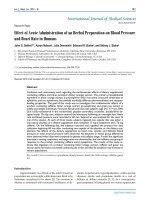

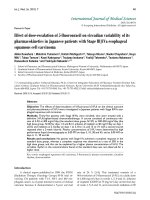
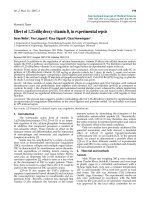
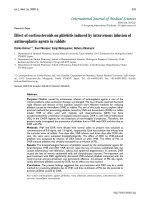

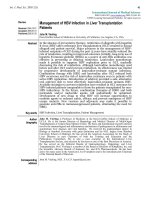
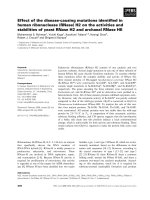
![Báo cáo Y học: Effect of adenosine 5¢-[b,c-imido]triphosphate on myosin head domain movements Saturation transfer EPR measurements without low-power phase setting ppt](https://media.store123doc.com/images/document/14/rc/vd/medium_vdd1395606111.jpg)